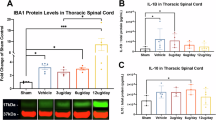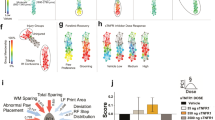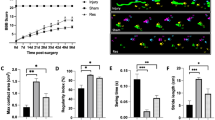Abstract
Study design:
An immunohistological assessment of substance P (SP), its NK1 receptor and claudin-5 in human spinal cord injury (SCI) tissue.
Objective:
To determine whether SP and NK1 receptor immunoreactivity are altered following human traumatic SCI.
Setting:
Australia.
Summary of background data:
SP has been implicated in the development of neurogenic inflammation and subsequent edema development following both traumatic brain injury and ischemic stroke. In these conditions, inhibition of its NK1 receptor has been shown to be neuroprotective as reflected in a reduction of edema and improved functional outcome. However, the role of SP following human SCI has not yet been assessed.
Methods:
Archived human SCI tissue was grouped according to survival times: control (no injury; n=5); immediate (death within an hour of the incident; n=6); 2–5 h (n=3); 3 days (n=5); 1 week (n=3); and 3–4 weeks (n=6). Sections were assessed for SP, its NK1 receptor and claudin-5 using immunohistochemical techniques.
Results:
Following SCI, dorsal horn SP immunoreactivity demonstrated a profound decrease compared with control tissue, indicating the loss of SP with SCI. A marked increase in perivascular NK1 staining was demonstrated after SCI compared with control levels. No obvious change in claudin-5 immunoreactivity was present immediately following injury, however, by 1 week post-SCI, decreased levels were noted.
Conclusion:
This study demonstrates that severe acute traumatic human SCI results in decreased SP and an immediate increase in NK1 receptor immunoreactivity, suggesting that there is a neurogenic inflammatory component following human SCI.
Similar content being viewed by others
Log in or create a free account to read this content
Gain free access to this article, as well as selected content from this journal and more on nature.com
or
References
Tator CH, Duncan EG, Edmonds VE, Lapczak LI, Andrews DF . Changes in epidemiology of acute spinal cord injury from 1947–1981. Surg Neurol 1993; 40: 207–215.
Bozzo A, Marcoux J, Radhakrishna M, Pelletier J, Goulet B . The role of magnetic resonance imaging in the management of acute spinal cord injury. J Neurotrauma 2011; 28: 1401–1411.
Leypold BG, Flanders AE, Burns AS . The early evolution of spinal cord lesions on MR imaging following traumatic spinal cord injury. AJNR Am J Neuroradiol 2008; 29: 1012–1016.
Sharma HS . Early microvascular reactions and blood-spinal cord barrier disruption are instrumental in pathophysiology of spinal cord injury and repair: novel therapeutic strategies including nanowired drug delivery to enhance neuroprotection. J Neural Transm 2011; 118: 155–176.
Koyanagi I, Iwasaki Y, Isu T, Akino M, Abe H . Significance of spinal cord swelling in the prognosis of acute cervical spinal cord injury. Paraplegia 1989; 27: 190–197.
Campos MM, Calixto JB . Neurokinin mediation of edema and inflammation. Neuropeptides 2000; 34: 314–322.
Harrison S, Geppetti P . Substance p. Int J Biochem Cell Biol 2001; 33: 555–576.
O'Connor TM, O'Connell J, O'Brien DI, Goode T, Bredin CP, Shanahan F . The role of substance P in inflammatory disease. J Cell Physiol 2004; 201: 167–180.
Donkin JJ, Nimmo AJ, Cernak I, Blumbergs PC, Vink R . Substance P is associated with the development of brain edema and functional deficits after traumatic brain injury. J Cereb Blood Flow Metab 2009;; 29: 1388–1398.
Turner RJ, Helps SC, Thornton E, Vink R . A substance P antagonist improves outcome when administered 4 h after onset of ischaemic stroke. Brain Res 2011; 1393: 84–90.
Olsson Y, Ahlgren S, Farooque M, Holtz A, Li GL, Yu WR . Pathophysiology of spinal cord trauma: observations on vasogenic oedema and axonal injuries in human and experimental material. Neuropathol Appl Neurobiol 1996; 22: 518–520.
Morita K, Sasaki H, Furuse M, Tsukita S . Endothelial claudin: claudin-5/TMVCF constitutes tight junction strands in endothelial cells. J Cell Biol 1999; 147: 185–194.
Norenberg MD, Smith J, Marcillo A . The pathology of human spinal cord injury: defining the problems. J Neurotrauma 2004; 21: 429–440.
Przewlocki R, Gramsch C, Pasi A, Herz A . Characterization and localization of immunoreactive dynorphin, alpha-neo-endorphin, Met-enkephalin and substance P in human spinal cord. Brain Res 1983; 280: 95–103.
Pearson J, Brandeis L, Cuello AC . Depletion of substance P-containing axons in substantia gelatinosa of patients with diminished pain sensitivity. Nature 1982; 295: 61–63.
Nimmo AJ, Cernak I, Heath DL, Hu X, Bennett CJ, Vink R . Neurogenic inflammation is associated with development of edema and functional deficits following traumatic brain injury in rats. Neuropeptides 2004; 38: 40–47.
Maeno H, Kiyama H, Tohyama M . Distribution of the substance P receptor (NK-1 receptor) in the central nervous system. Brain Res Mol Brain Res 1993; 18: 43–58.
Nakaya Y, Kaneko T, Shigemoto R, Nakanishi S, Mizuno N . Immunohistochemical localization of substance P receptor in the central nervous system of the adult rat. J Comp Neurol 1994; 347: 249–274.
Mantyh PW . Neurobiology of substance P and the NK1 receptor. J Clin Psychiatry 2002; 63 (Suppl 11)): 6–10.
Nitta T, Hata M, Gotoh S, Seo Y, Sasaki H, Hashimoto N et al. Size-selective loosening of the blood-brain barrier in claudin-5-deficient mice. J Cell Biol 2003; 161: 653–660.
Acknowledgements
We acknowledge the financial support of the Neil Sachse Foundation.
Author information
Authors and Affiliations
Corresponding author
Ethics declarations
Competing interests
The authors declare no conflict of interest.
Rights and permissions
About this article
Cite this article
Leonard, A., Manavis, J., Blumbergs, P. et al. Changes in substance P and NK1 receptor immunohistochemistry following human spinal cord injury. Spinal Cord 52, 17–23 (2014). https://doi.org/10.1038/sc.2013.136
Received:
Revised:
Accepted:
Published:
Issue date:
DOI: https://doi.org/10.1038/sc.2013.136
Keywords
This article is cited by
-
A multi-staged neuropeptide response to traumatic brain injury
European Journal of Trauma and Emergency Surgery (2022)
-
When the Nervous System Turns Skeletal Muscles into Bones: How to Solve the Conundrum of Neurogenic Heterotopic Ossification
Current Osteoporosis Reports (2020)



